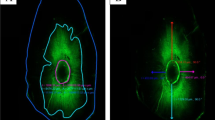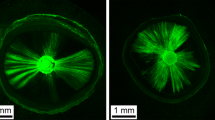Abstract
Objectives
The aim of the present study is to evaluate the possible correlation between sealer penetration into dentinal tubules and sealing ability both in presence and absence of smear layer.
Materials and methods
Fourteen maxillary central incisors were treated with 5.25 % NaOCl +10 % EDTA to remove the smear layer (SL-free group) or 5.25 % NaOCl without EDTA (SL group). Root canals were filled using #25 Thermafil Obturators with Topseal sealer labelled with 0.1 wt% rhodamine B. Sealing ability was measured as fluid filtration rate with a fluid-flow meter using water supplemented with 0.3 % calcein fluorescent dye. Specimens were sectioned, observed under confocal microscope to co-localize the presence of sealer (rhodamine B labelling) into dentinal tubules and gaps (calcein labelling) into the root canal. The depth of sealer penetration into dentinal tubules and the percentage of sealer penetration around the root canal were measured at 3, 5 and 8 mm from the apex.
Results
No significant differences between groups were observed in fluid filtration rate nor in depth of calcein penetration. Sealer penetration depth and percentage into dentinal tubules were not significantly different between groups, except at 8-mm level in absence of smear layer.
Conclusion
Sealer penetration at 3- and 5-mm levels was not influenced by smear layer while it was significantly reduced at 8-mm level. Fluid filtration rate was not correlated either with depth of calcein penetration nor with sealer penetration into dentinal tubules.
Clinical relevance
The sealing ability of Topseal sealer is not affected by presence or absence of smear layer.





Similar content being viewed by others
References
Mamootil K, Messer HH (2007) Penetration of dentinal tubules by endodontic sealer cements in extracted teeth and in vivo. Int Endod J 40:873–881
Torabinejad M, Ung B, Kettering JD (1990) In vitro bacterial penetration of coronally unsealed endodontically treated teeth. J Endod 16:566–569
Trope M, Chow E, Nissan R (1995) In vitro endotoxin penetration of coronally unsealed endodontically treated teeth. Endod Dent Traumatol 11:90–94
Ardizzoni A, Generali L, Righi E, et al. (2014) Differential efficacy of endodontic obturation procedures: an ex vivo study. Odontology 102:223–231
Gandolfi MG, Parrilli AP, Fini M, Prati C, Dummer PM (2013) 3D micro-CT analysis of the interface voids associated with Thermafil root fillings used with AH Plus or a flowable MTA sealer. Int Endod J 46:253–263
Foschi F, Nucci C, Montebugnoli L, et al. (2004) SEM evaluation of canal wall dentine following use of Mtwo and ProTaper NiTi rotary instruments. Int Endod J 37:832–839
Prati C, Foschi F, Nucci C, Montebugnoli L, Marchionni S (2004) Appearance of the root canal walls after preparation with NiTi rotary instruments: a comparative SEM investigation. Clin Oral Invest 8:102–110
Gharib SR, Tordik PA, Imamura GM, Baginski TA, Goodell GG (2007) A confocal laser scanning microscope investigation of the Ephiphany obturation system. J Endod 33:957–961
Balguerie E, van der Sluis L, Vallaeys K, Gurgel-Georgelin M, Diemer F (2011) Sealer penetration and adaptation in the dentinal tubules: a scanning electron microscopic study. J Endod 37:1576–1579
Kara Tuncer A, Tuncer S (2012) Effect of different final irrigation solutions on dentinal tubule penetration depth and percentage of root canal sealer. J Endod 38:860–863
Bolles JA, He J, Svoboda KKH, Schneiderman E, Glickman GN (2013) Comparison of vibringe, endoactivator and needle irrigation on sealer penetration in extracted human teeth. J Endod 39:708–711
Kuçj A, Alaçam T, Yavaş O, Ergul-Ulger Z, Kayaoglu G (2014) Sealer penetration into dentinal tubules in the presence or absence of smear layer: a confocal laser scanning microscopic study. J Endod 40:1627–1631
White RR, Goldman M, Lin PS (1984) The influence of the smear layer upon dentinal tubule penetration by plastic filling materials. J Endod 10:558–562
Çalt S, Serper A (1999) Dentinal tubule penetration of root canal sealers after root canal dressing with calcium hydroxide. J Endod 25:431–433
Patel DV, Sherriff M, Ford TR, et al. (2007) The penetration of RealSeal primer and Tubliseal into root canal dentinal tubules: a confocal microscopic study. Int Endod J 40:67–71
Ordinola-Zapata R, Bramante CM, Bernardineli N, et al. (2009) A preliminary study of the percentage of sealer penetration in roots obturated with the Thermafil and RealSeal-1 obturation techniques in mesial root canals of mandibular molars. Oral Surg Oral Med Oral Pathol Oral Radiol Endod 108:961–968
Şen BH, Pişkin B, Baran N (1996) The effect of tubular penetration of root canal sealers on dye microleakage. Int Endod J 29:23–28
Engel GT, Goodell GG, McClanahan SB (2005) Sealer penetration and apical microleakage in smear-free dentin after a final rinse with either 70 % isopropyl alcohol or Peridex. J Endod 31:620–623
Stevens RW, Strother JM, Mcclanahan SB (2006) Leakage and sealer penetration in smear-free dentin after a final rinse with 95 % ethanol. J Endod 32:785–788
De Deus G, Brandão MC, Leal F, et al. (2012) Lack of correlation between sealer penetration into dentinal tubules and sealability in nonbonded root fillings. Int Endod J 45:642–651
Machado R, Silva Neto UX, Cameiro E, Fariniuk LF, Westphalen VPD, Cunha RS (2014) Lack of correlation between tubular dentine cement penetration, adhesiveness and leakage in roots filled with gutta percha and an endodontic cement based on epoxy amine resin. J Appl Oral Sci 22:22–28
McComb D, Smith DC (1975) A preliminary scanning electron microscopic study of root canals after endodontic procedures. J Endod 1:238–242
Cergneux M, Ciucchi B, Dietschi JM, Holz J (1987) The influence of the smear layer on the sealing ability of canal obturation. Int Endod J 20:228–232
Shahravan A, Haghdoost AA, Adl A, Rahimi H, Shadifar F (2007) Effect of smear layer on sealing ability of canal obturation: a systematic review and meta-analysis. J Endod 33:96–105
Şen BH, Wesselink PR, Türkün M (1995) The smear layer: a phenomenon in root canal therapy. Int Endod J 28:141–148
Çalt S, Serper A (2002) Time-dependent effects of EDTA on dentin structures. J Endod 28:17–19
Saleh IM, Ruyter IE, Haapasalo M, Ørstavik D (2002) The effects of dentine pretreatment on the adhesion of root-canal sealers. Int Endod J 35:859–866
Michelich VJ, Schuster GS, Pashley DH (1980) Bacterial penetration of human dentin in vitro. J Dent Res 59:1398–1403
Torabinejad M, Handysides R, Khademi AA, Bakland LK (2002) Clinical implications of the smear layer in endodontics: a review. Oral Surg Oral Med Oral Phatol Oral Radiol Endod 94:658–666
Generali L, Righi E, Todesca MV, Consolo U (2014) Canal shaping with WaveOne reciprocating files: influence of operator experience on instrument breakage and canal preparation time. Odontology 102:217–222
Gandolfi MG, Prati C (2010) MTA and F-doped MTA cements used as sealers with warm gutta-percha. Long-term study of sealing ability. Int Endod J 43:889–901
Iacono F, Pedullà E, Rapisarda E, Prati C, Gandolfi MG (2014) Long term stability of different obturation systems after 12 months in simulated body fluids. Gen Dent 62:20–23
Camilleri J, Gandolfi MG, Siboni F, Prati C (2011) Dynamic sealing ability of MTA root canal sealer. Int Endod J 44:9–20
Bitter K, Paris S, Martus P, Schartner R, Kielbassa AM (2004) A confocal laser scanning microscope investigation of different dental adhesives bonded to root canal dentine. Int Endod J 37:840–848
Weis MV, Parashos P, Messer HH (2004) Effect of obturation technique on sealer cement thickness and dentinal tubule penetration. Int Endod J 37:653–663
Kok D, Húngaro Duarte MA, Abreu Da Rosa R, Wagner MH, Pereira JR, Só MV (2012) Evaluation of epoxy resin sealer after three root canal filling technique by confocal laser scanning microscopy. Microsc Res Tech 75:1277–1280
D’Alpino PH, Pereira JC, Svizero NR, Rueggeberg FA, Pashley DH (2006) Use of fluorescent compounds in assessing bonded resin-based restorations: a literature review. J Dent 34:623–634
Watson TF (1989) A confocal optical microscope study of the morphology of the tooth/restoration interface using Scotchbond 2 dentin adhesive. J Dent Res 68:1124–1131
Griffiths BM, Watson TF (1995) Resin–dentin interface of scotchbond multi-purpose dentin adhesive. Am J Dent 8:212–216
Hilton TJ (2002) Can modern restorative procedures and materials reliably seal cavities? In vitro investigations. Part 1. Am J Dent 15:198–210
De Deus G (2008) New directions in old leakage models. Int Endod J 41:720–721
Oksan T, Aktener BO, Sen BH, Tezel H (1993) The penetration of root canal sealers into dentinal tubules. A scanning electron microscopic study. Int Endod J 26:301–305
Kokkas AB, Boutsioukis AC, Vassiliadis LP, Stavrianos CK (2004) The influence of the smear layer on dentinal tubule penetration depth by three different root canal sealers: an in vitro study. J Endod 30:100–102
Zhou HM, Shen Y, Zheng W, Li L, Zheng YF, Haapasalo M (2013) Physical properties of 5 root canal sealers. J Endod 39:1281–1286
Vassiliadis LP, Sklavounos SA, Stavrianos CK (1994) Depth of penetration and appearance of Grossman sealer in the dentinal tubules: an in vivo study. J Endod 20:373–376
Mjör IA, Nordhal I (1996) The density and branching of dentinal tubules in human teeth. Arch Oral Biol 41:401–412
Beust TB (1931) Reactions of the dentinal fibril to external irritation. J Am Dent Assoc 18:1060–1073
Vasiliadis I, Darling AI, Levers BGH (1983) The amount and distribution of sclerotic human root dentine. Arch Oral Biol 28:645–649
Russel AA, Chandler NP, Haumann C, Siddiqui AY, Tompkins GR (2013) The butterfly effect: an investigation of sectioned roots. J Endod 39:208–210
Van Huysen G (1960) The microstructure of normal and sclerosed dentin. J Prosthet Dent 10:976–982
Giardino L, Cavani F, Generali L (2016) Sodium hypochlorite solution penetration into human dentine: a histochemical evaluation. Int Endod J. doi:10.1111/iej.12641
Author information
Authors and Affiliations
Corresponding author
Ethics declarations
Conflict of interest
The authors declare that they have no conflict of interest.
Funding
The work was supported by the Department of Surgery, Medicine, Dentistry and Morphological Sciences with Transplant Surgery, Oncology and Regenerative Medicine Relevance, University of Modena and Reggio Emilia, Modena, Italy.
Ethical approval
This article does not contain any studies with human participants or animals performed by any of the authors.
Informed consent
For this type of study, formal consent is not required.
Rights and permissions
About this article
Cite this article
Generali, L., Prati, C., Pirani, C. et al. Double dye technique and fluid filtration test to evaluate early sealing ability of an endodontic sealer. Clin Oral Invest 21, 1267–1276 (2017). https://doi.org/10.1007/s00784-016-1878-0
Received:
Accepted:
Published:
Issue Date:
DOI: https://doi.org/10.1007/s00784-016-1878-0




